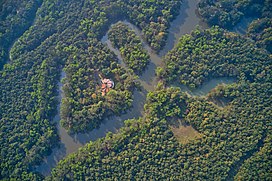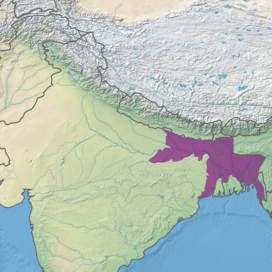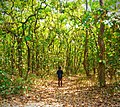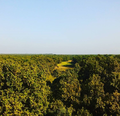Lower Gangetic Plains moist deciduous forests
| Lower Gangetic plains moist deciduous forests | |
|---|---|
 | |
 Ecoregion territory (in purple) | |
| Ecology | |
| Realm | Indomalayan |
| Biome | tropical and subtropical moist broadleaf forests |
| Borders | List
|
| Bird species | 380+ |
| Mammal species | 126 |
| Geography | |
| Area | 254,100 km2 (98,100 sq mi) |
| Countries | |
| States | |
| Coordinates | 24°02′N 89°53′E / 24.033°N 89.883°E |
| Conservation | |
| Conservation status | Critical/endangered[1] |
| Protected | 2.76% |
The Lower Gangetic Plains moist deciduous forests is a tropical and subtropical moist broadleaf forests ecoregion of Bangladesh and India. The ecoregion covers an area of 254,100 square kilometres (98,100 sq mi), comprising most of Bangladesh and the Indian states of West Bengal, Bihar and Tripura, and extending into adjacent states of Odisha, Uttar Pradesh and a tiny part of Assam, as well as adjacent western Myanmar.
Geography
The Lower Gangetic Plains moist deciduous forests extends across the
The ecoregion is bounded on the east and northeast by montane tropical rain forests; the
The ecoregion is home to several large cities, including Kolkata, Dhaka, Patna, and Chittagong.
Climate
The climate of the ecoregion is tropical and humid. Most of the annual rainfall comes during the southwest monsoon from June to September.
Flora
The natural vegetation is mostly semi-evergreen forest.
The upper canopy is predominantly of deciduous trees, with a lower storey of evergreen trees. Characteristic trees in disturbed forests are
Riparian forests are typically an Acacia-Dalbergia association, with
-
Seasonal flooding
-
Inside the forests
-
Endless forest in a flat landscape. Nowadays a rare sight.
Fauna
The ecoregion is home to 126 native mammal species. They include threatened species like the
The ecoregion is home to 380 species of birds species, including the

-
Where the undergrowth is sparse, monitor lizards can roam.
-
Peacocks
-
Various bird species (fantail bird)
-
Common tiger butterfliy
-
Dragonfliescan hunt on the open waters
Conservation
The ecoregion has been densely settled for many centuries, yet much forest remained until the early 20th century. Forest clearance accelerated during the 20th century, and by the end of the century, only 3% of the ecoregion remained in natural forest. Remaining forest areas are mostly small patches, except for one large block of forest south of Varanasi.[2]
In 1997, the

- Chota Nagpur dry deciduous forests)
- Udaipur Wildlife Sanctuary, Bihar (50 km²)
- Kaimur Wildlife Sanctuary, Bihar (2,370 km²)
- Chandra Prabha Wildlife Sanctuary, Uttar Pradesh (80 km²)
- Rajgir Wildlife Sanctuary, Bihar (290 km²)
- Kaimoor Wildlife Sanctuary, Uttar Pradesh (120 km²)
- Valmiki National Park, Bihar (230 km²; also extends into the Himalayan subtropical broadleaf forests)
- Raiganj Wildlife Sanctuary, West Bengal (40 km²)
- Kabartal Bird Sanctuary, Bihar (30 km²)
- Ramsagar National Park, Bangladesh (10 km²)
- Vikramshila Gangetic Dolphin Sanctuary, Bihar 160 km²)
- Nakti Dam Wildlife Sanctuary, Bihar (200 km²)
- Narendrapur Wildlife Sanctuary, West Bengal (90 km²)
- Jaldapara National Park, West Bengal (70 km²)
- Chalan Beel Wildlife Sanctuary, Bangladesh (170 km²)
- Bil Bhatia Wildlife Sanctuary, Bangladesh (30 km²)
- Madhupur National Park, Bangladesh (110 km²)
- Hail Haor Wildlife Sanctuary, Bangladesh (100 km²)
- Roa Wildlife Sanctuary, Tripura (10 km²)
- Bhawal National Park, Bangladesh (90 km²)
- Rema-Kalenga Wildlife Sanctuary, Bangladesh (50 km²)
- Gumti Wildlife Sanctuary, Tripura (420 km²)
- Sepahijala Wildlife Sanctuary, Tripura (20 km²)
- Trishna Wildlife Sanctuary, Tripura (270 km²)
- Aila Beel Wildlife Sanctuary, Bangladesh (30 km²)
- Kawadighi Haor Wildlife Sanctuary, Bangladesh (10 km²)
- Unnamed (20 km²)
- Dakhar Haor Wildlife Sanctuary, Bangladesh (40 km²)
- Dubriar Haor Wildlife Sanctuary, Bangladesh (20 km²)
- Erali Beel Wildlife Sanctuary, Bangladesh (10 km²)
- Hakaluki Haor Wildlife Sanctuary, Bangladesh (160 km²)
- Kawadighi Haor Wildlife Sanctuary, Bangladesh (20 km²)
- Kuri Beel Wildlife Sanctuary, Bangladesh (30 km²)
- Meda Beel Wildlife Sanctuary, Bangladesh (20 km²)
- Rajkandi Wildlife Sanctuary, Bangladesh (50 km²)
- Tangua Haor Wildlife Sanctuary, Bangladesh 160 km²)
- West Bhanugach Wildlife Sanctuary, Bangladesh (50 km²)
- Hazarikhil Wildlife Sanctuary, Bangladesh (30 km²)
- Rampahar-Sitapahar Wildlife Sanctuary, Bangladesh (10 km²)
- Chunati Wildlife Sanctuary, Bangladesh (90 km²)
- Chimbuk Wildlife Sanctuary, Bangladesh (30 km²)
- Himchari National Park, Bangladesh (20 km²)
- Teknaf Wildlife Sanctuary, Bangladesh (100 km²)
- Sangu Matamuhari, Bangladesh (960 km²)
References
External links
- "Lower Gangetic plains moist deciduous forests". Terrestrial Ecoregions. World Wildlife Fund.
- "Ecoregions 2017". Resolve.
Geographical ecoregion maps and basic info.













